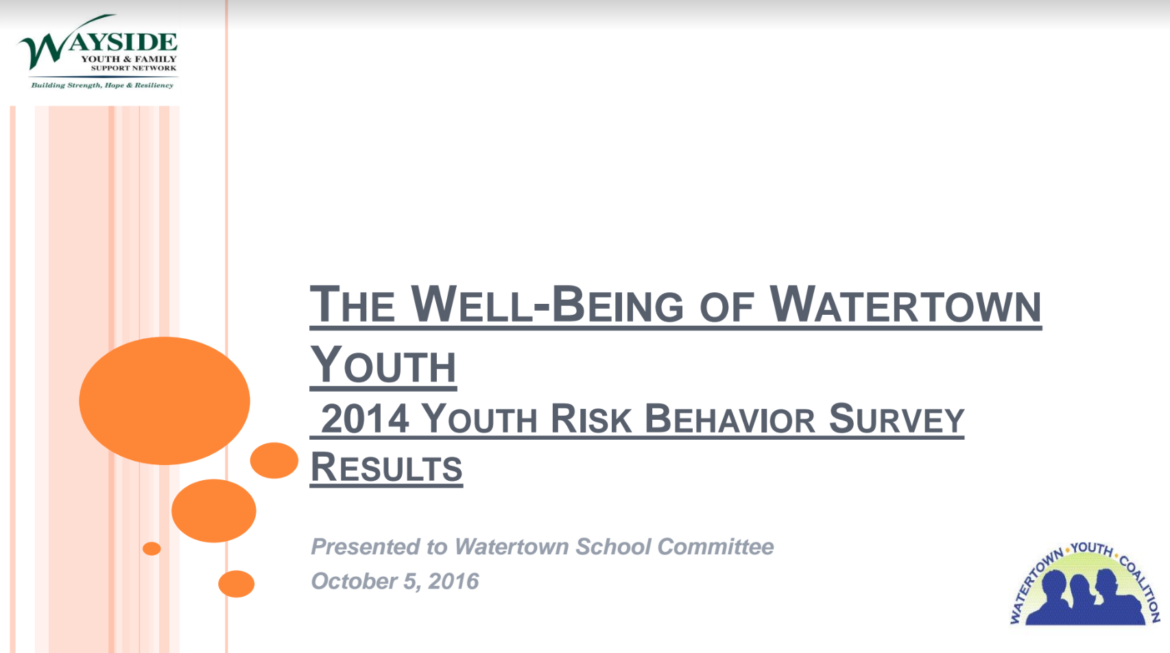
The biggest concern for Watertown youth is their access to alcohol, said members of the Watertown Youth Coalition, but other drugs, including prescription opiates, as well as depression and suicide also rank high in the latest Watertown Youth Risk Behavior Survey.
The Watertown Youth Coalition received surveys from 73 percent of Watertown High School students and 87 percent of Watertown Middle Schoolers in the 2014 survey, Stephanie Sunderland-Ramsey, Prevention Program coordinator for the Wayside Multi-Service Center, told the School Committee last week.
The survey (click here to see) covers tobacco use, drinking, marijuana, cocaine, prescription drugs and opioids, as well as bullying, depression and suicide attempts. Surveys stretch back 16 years, and are given every two or three years. Sunderland-Ramsey said she hopes to survey students in the spring of 2017.
Students who said they have ever consumed alcohol is down slightly for high schoolers to just under 60 percent, and quite a bit down for middle school students at 16 percent. Marijuana use was flat at the high school at about 40 percent and down quite a bit to 5 percent at WMS.
The data on prescription drug use does not go back as far and questions have changed, so trends are harder to spot, Sunderland-Ramsey said. It appears to be about the same as past surveys, about 1 in 10 students at the high school.
The rate of depression increase at the high school to over a quarter of students.
There is also good news from the latest survey, she said. “We see tobacco use has gone down consistently from year to year,” Sunderland-Ramsey said. “We are working on e-cigarettes and vapes now.”
When asked about the area of most concern, however, Sunderland-Ramsey said cutting down the amount of drinking by students.
“We are working on underage alcohol use because it is a gateway to other drugs,” Sunderland-Ramsey said. “Marijuana is important, too.”
Students have easier access to alcohol than other substances, she said.
“Access to alcohol is a concern,” Sunderland-Ramsey said. “Clearly getting it from their siblings or a friend is a problem that continues.”
Some old school parenting helps cut down on the amount of drinking by youth, Sunderland-Ramsey said.
“We need to work with parents to monitor youth use and information,” Sunderland-Ramsey said. “We find when parents say they do not want their children using alcohol in the home, they listen.”
When they spoke to students, the Watertown Youth Coalition found young people wanted to be talked to more like an adult, and they wanted practical information.
“They want the truth about how to deal with a friend drinking too much,” Sunderland-Ramsey said. “(They say) It is going to happen and they want to be able to deal with how to prevent it from happening again.”
Two risk factors that lead to more young people drinking and using other drugs are stress and bullying.
“If a youth believe they are bullied, they are at higher risk across the board of substance abuse,” Sunderland-Ramsey said.
Similar findings were found with stress, she added.
School Committee member Candace Miller said she was concerned about the rate of depression and suicide attempts, especially since a student at Watertown High School took his life a few years ago.
Youth are not the only ones who should be mindful of the culture of substance use in today’s society, said School Committee member Eileen Hsu-Balzer.
“Can you watch a football game without seeing an aid for alcohol? No,” Hsu-Balzer said. “They see people smoking, they see happy hour advertisements at bars.
“Maybe we should be teaching students about how to help someone not drink if they don’t want to.”